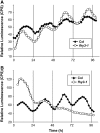Arabidopsis FHY3 specifically gates phytochrome signaling to the circadian clock
- PMID: 17012604
- PMCID: PMC1626623
- DOI: 10.1105/tpc.105.037358
Arabidopsis FHY3 specifically gates phytochrome signaling to the circadian clock
Abstract
Circadian gating of light signaling limits the timing of maximum responsiveness to light to specific times of day. The fhy3 (for far-red elongated hypocotyl3) mutant of Arabidopsis thaliana is involved in independently gating signaling from a group of photoreceptors to an individual response. fhy3 shows an enhanced response to red light during seedling deetiolation. Analysis of two independent fhy3 alleles links enhanced inhibition of hypocotyl elongation in response to red light with an arrhythmic pattern of hypocotyl elongation. Both alleles also show disrupted rhythmicity of central-clock and clock-output gene expression in constant red light. fhy3 exhibits aberrant phase advances under red light pulses during the subjective day. Release-from-light experiments demonstrate clock disruption in fhy3 during the early part of the subjective day in constant red light, suggesting that FHY3 is important in gating red light signaling for clock resetting. The FHY3 gating function appears crucial in the early part of the day for the maintenance of rhythmicity under these conditions. However, unlike previously described Arabidopsis gating mutants that gate all light signaling, gating of direct red light-induced gene expression in fhy3 is unaffected. FHY3 appears to be a novel gating factor, specifically in gating red light signaling to the clock during daytime.
Figures








Similar articles
-
Genetic linkages between circadian clock-associated components and phytochrome-dependent red light signal transduction in Arabidopsis thaliana.Plant Cell Physiol. 2007 Jul;48(7):971-83. doi: 10.1093/pcp/pcm063. Epub 2007 May 22. Plant Cell Physiol. 2007. PMID: 17519251
-
Arabidopsis FRS4/CPD25 and FHY3/CPD45 work cooperatively to promote the expression of the chloroplast division gene ARC5 and chloroplast division.Plant J. 2013 Sep;75(5):795-807. doi: 10.1111/tpj.12240. Epub 2013 Jun 5. Plant J. 2013. PMID: 23662592
-
Transcription Factors FHY3 and FAR1 Regulate Light-Induced CIRCADIAN CLOCK ASSOCIATED1 Gene Expression in Arabidopsis.Plant Cell. 2020 May;32(5):1464-1478. doi: 10.1105/tpc.19.00981. Epub 2020 Mar 9. Plant Cell. 2020. PMID: 32152179 Free PMC article.
-
Multifaceted roles of FHY3 and FAR1 in light signaling and beyond.Trends Plant Sci. 2015 Jul;20(7):453-61. doi: 10.1016/j.tplants.2015.04.003. Epub 2015 May 5. Trends Plant Sci. 2015. PMID: 25956482 Review.
-
Emerging Roles of FHY3 and FAR1 as System Integrators in Plant Development.Plant Cell Physiol. 2023 Oct 16;64(10):1139-1145. doi: 10.1093/pcp/pcad068. Plant Cell Physiol. 2023. PMID: 37384577 Review.
Cited by
-
FAR-RED ELONGATED HYPOCOTYL3 promotes floral meristem determinacy in Arabidopsis.Plant Signal Behav. 2016 Oct 2;11(10):e1238545. doi: 10.1080/15592324.2016.1238545. Plant Signal Behav. 2016. PMID: 27660915 Free PMC article.
-
Circadian entrainment in Arabidopsis.Plant Physiol. 2022 Sep 28;190(2):981-993. doi: 10.1093/plphys/kiac204. Plant Physiol. 2022. PMID: 35512209 Free PMC article.
-
The dark side of clock-controlled flowering.F1000 Biol Rep. 2009 Jul 27;1:57. doi: 10.3410/B1-57. F1000 Biol Rep. 2009. PMID: 20948627 Free PMC article.
-
Coordinative regulation of plants growth and development by light and circadian clock.aBIOTECH. 2021 Mar 27;2(2):176-189. doi: 10.1007/s42994-021-00041-6. eCollection 2021 Jun. aBIOTECH. 2021. PMID: 36304756 Free PMC article. Review.
-
The circadian clock regulates auxin signaling and responses in Arabidopsis.PLoS Biol. 2007 Aug;5(8):e222. doi: 10.1371/journal.pbio.0050222. PLoS Biol. 2007. PMID: 17683202 Free PMC article.
References
-
- Alabadi, D., Oyama, T., Yanovsky, M.J., Harmon, F.G., Más, P., and Kay, S.A. (2001). Reciprocal regulation between TOC1 and LHY/CCA1 within the Arabidopsis circadian clock. Science 293 880–883. - PubMed
-
- Cashmore, A.R. (2005). Cryptochromes. In Photomorphogenesis in Plants and Bacteria, E. Schafer and F. Nagy, eds (Dordrecht, The Netherlands: Springer), pp. 379–406.
-
- Devlin, P.F. (2002). Signs of the time: Environmental input to the circadian clock. J. Exp. Bot. 53 1535–1550. - PubMed
-
- Devlin, P.F. (2006). Circadian regulation of photomorphogenesis. In Photomorphogenesis in Plants and Bacteria, E. Schafer and F. Nagy, eds (Dordrecht, The Netherlands: Springer), pp. 567–604.
Publication types
MeSH terms
Substances
LinkOut - more resources
Full Text Sources
Molecular Biology Databases

